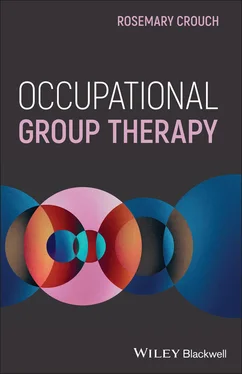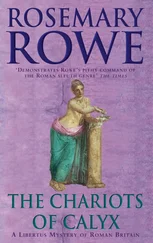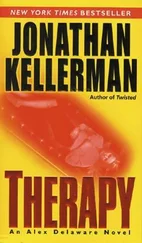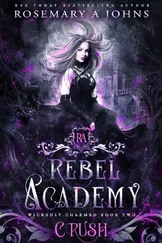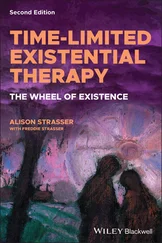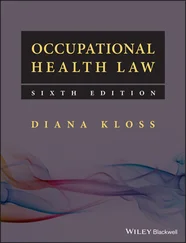Included in Casteleijn's (2014) study is the Creative Participation Assessment Tool (CPA) which is a descriptive tool developed by van der Reyden in 2002 and has been used by occupational therapists and students to assess creative ability of participants in groups and individually. In 2002 Casteleijn and Smit adapted the CPA and established that it is valid and reliable.
Mona Eklund well‐known occupational therapist in Scandinavia, published a paper on the Wile Online Library in April 2006 entitled ‘Therapeutic Factors in Occupational Group Therapy identified by patients discharged from a Psychiatric Day Centre and their significant others’. She found that the most important factors of the group dimension were group interaction, talking in a group and the therapist's attitude and behaviour.
In 2019 Christopher undertook research into occupational therapy groups as a vehicle to address interpersonal relationship problems. Their study was aimed at the mental health care users' perceptions. This is a qualitative study where 11 groups specifically directed at interpersonal relationships were carried out. This study has specific reference to the content of this book and many of the chapters relate to occupational group therapy. The authors discuss how group members experienced a ‘downward spiral’ in interpersonal relationships supposedly caused by their mental illness. ‘During group therapy, this downward cycle appeared to start to reverse, as the participant received acceptance, authentic support, and social connection. This seemed to have provided a safe place to practices social skills and as a result strengthen self‐esteem, and positive relationships, leading to a greater level of acceptance and mental health’ (in Radnitz et al. 2019, p. 8.). This article is highly recommended.
Very little research is to be found on group work with the physically disabled. Mehdizadeh et al. (2017) published an excellent research paper on stroke survivors and the effect of group‐based occupational therapy on performance and satisfaction. Their results show a significant change and improvement in ADL performance but unfortunately they do not state the effect that working in a group had on the clients.
CHAPTER 3 Models of Occupational Therapy Relevant to Occupational Group Therapy
3.1 THE FUNCTIONAL GROUP MODEL
This model was developed a long time ago by Howe and Schwartzberg (1986) but has some relevance to modern‐day occupational group therapy. The Functional Group Model is an occupational therapy approach to group work. Howe and Schwartzberg (1986) make three statements about the Functional orientation of the functional group:
‘Functional groups provide a place for members to function in the reality of the present and to practice skills in decision making, judgment, and perception, as well as in areas of specific deficits.
Functional groups are concerned with elements of performance as well as types of performance, such as work, play, and self‐ maintenance.
Functional groups seek to build group cohesiveness; a certain degree of cohesiveness is necessary to achieve functional goals’ (p. 99).
The reader will note that these statements are very much in line with modern thinking on occupational group therapy as discussed by Louise Fouché (in Chapter 4) and the Model of Occupational Performance (Law et al. 1994).
What is meant by a ‘Functional Group’ The aim of a Functional Group is for group members to take part in purposeful active participation. They are involved in a meaningful product which will bring about learning and skills and social interaction, address emotional needs, build on strengths and all of this will take place in the ‘here‐and‐now’ (Moreno 1975). It will be experiential in nature and spontaneous action should take place.
Howe and Schwartzberg (1986) state that ‘The process of establishing norms in a group helps the group interact in the “here and now” context because norms refer to immediate concerns’. They stress the importance of the genuine exploration of conflicts and problems which are shared by the group. The importance of spontaneity, as stressed by Moreno in 1975, brings about trust in the group which is essential in the early development of the group. This is known as the formative stage of a group and is defined by a number of theorists e.g. Tubbs and Moss (1981). The development stage builds on the formative stage. The occupational group therapist will adapt the task to meet the development of the group as explained clearly by Louise Fouché (2020). Once the group members have worked out conflict issues, tested the safety of the group and any power struggles etc. they can continue into the “Work phase”.
Formal research has been undertaken in South Africa on a Model of Occupational Therapy called the VdTMoCA (the Vona duToit Model of Creative Ability).This model does not specifically address a model of group work but is very relevant to patients and clients treated by occupational therapists in groups. According to van der Reyden and Sherwood (2019) ‘The VdTMoCA provides a theoretical framework for understanding people and their activity participation in terms of creative ability, which has a specific meaning in this model’ (p.60).
Much emphasis is placed today on the diligent assessment of patients/clients who are selected to participate in a group as part of their therapy, particularly in occupational therapy. It is extremely important for patients/clients to derive the maximum benefit from their group therapy by being chosen to be in a group with other people who actively participate in their lives at the same, or similar, level of creative ability.
Meaningful activity participation is perhaps the most important concept in this theory which directly relates to occupational group therapy. Du Toit states in 1962 that ‘It is thus through activity participation that there is the experience of living, the potential for growth, and realisation of one's capabilities and potential i.e. realisation of one's self’ (p. 65).
De Witt and Sherwood (2019) in their discussion of du Toit's Model mention situations in relation to behaviours, and adherence to various norms related to relational engagement in group activities. As noted by Louise Fouché in her work, a group provides an excellent opportunity for the occupational therapists to observe how group members relate to each other. De Witt and Sherwood (2019) noted that ‘relational contact with others can be observed through the person's ability to recognise others and engage with them in a socially appropriate manner through greetings, taking of instruction or directions, sharing of tools, materials and space’ (p. 170).
It is acknowledged that there are other factors that are important too in selecting members of a group such as age and diagnosis. These are factors that are interwoven into creative ability but can also stand alone, e.g. selecting an homogeneous group of elderly, depressed women, although functioning on the same level of creative ability, will lead to disaster. There will be little motivation and could lead to an increase in depression. It is generally acknowledged by group therapists that groups should be heterogeneous.
3.3 THE CANADIAN MODEL OF OCCUPATIONAL PERFORMANCE (CMOP)
This model which was developed in 1991 is widely used throughout the world. It defines the three basic areas of occupational performance, i.e. self‐care, productivity and leisure. See Figure 3.1below.
The Canadian Occupational Performance Measure (COPM) based on the CMOP was developed as ‘an individualised measure of a client's self‐perception in occupational performance, and is designed to be used in client‐centred occupational therapy practice’. (Law et al. 1994).
Читать дальше
